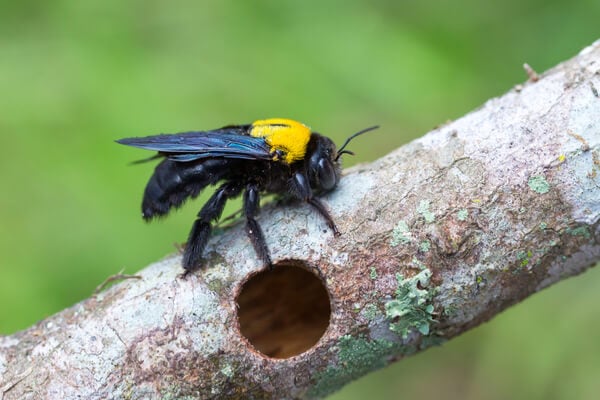Carpenter Bee Control

Carpenter Bees get their common name from their habit of boring into wood to make galleries for the rearing of young. These stinging insects can be found worldwide, with seven sub-species occurring specifically in the United States. The eastern carpenter bee in particular is common in Ohio.
BEHAVIOR
Carpenter bees are not social insects and do not live in nests or colonies. The adults overwinter, typically in abandoned nest galleries. In the spring, the survivors emerge and feed on nectar. Then mating begins and extends into nest-construction time.
Females of the eastern carpenter bee will nest in a wide range of woods, but prefer weathered and unpainted wood. Male carpenter bees tend to be territorial and often become aggressive when humans approach, sometimes hovering a short distance in front of one’s face or buzzing around one’s head. Since males have no stinger, these actions are merely show. However, the female does have a potent sting which is rarely used.
CONTROL AND PREVENTION
Carpenter bees rarely attack freshly painted or stained wood. They can be discouraged from boring into wood by applying a clear waterproofing product or varnish yearly, early in spring. Carpenter bees have difficulty clinging to smooth, glossy surfaces, which is why this is an effective preventative measure. Treated and abandoned entrance holes should be patched with wood filler and refinished to help prevent further use by carpenter bees.
APPEARANCE
Carpenter bees resemble bumblebees. They are of a similar size and have similar yellow and black markings alongside a fluffy-looking body. The main difference is that the abdomen of carpenter bees is only partially covered in hair while bumblebees are completely covered. Carpenter bees are not social insects and do not live in nests or colonies.
PROFESSIONAL CONTROL
When you contact us with concerns about a carpenter bee infestation, a Plunkett’s technician will come quickly to assess the situation. One of the first steps they’ll take will be to treat each individual entry hole and gallery with an appropriately labeled residual insecticide. Aerosol injection systems, compressed air sprayers and dust application equipment are most often used to treat galleries, with or without a ladder, depending on the situation. Treatment efficacy is best on chilly, overcast and rainy days when bees take refuge in their galleries.







